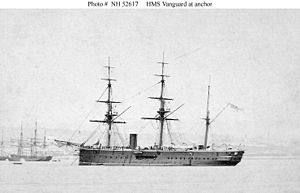Audacious class battleship

HMS Vanguard with the later barque rig
|
|
| Class overview | |
|---|---|
| Name: | Audacious class |
| Built: | 1867-1870 |
| In commission: | 1870-1927 |
| Completed: | 4 |
| Lost: | 2 |
| General characteristics | |
| Type: | Ironclad warship |
| Displacement: | Audacious/Invincible: 6,106 tonnes Iron Duke/Vanguard: 6,034 tons |
| Length: | Audacious/Invincible: 280 ft (85 m) Iron Duke/Vanguard: 341 ft 3 in (104.01 m) |
| Beam: | 54 ft (16 m) |
| Draught: | Audacious/Invincible: 22 ft 7 in (6.88 m) Iron Duke/Vanguard: 23 ft 2 in (7.06 m) |
| Propulsion: | Coal-fired reciprocating steam engines 6 boilers 2 shafts |
| Sail plan: | Full rigged ship later converted to barque-rig |
| Speed: | Audacious/Invincible: 13.5 knots (25.0 km/h; 15.5 mph) Iron Duke/Vanguard: 13 knots (24 km/h; 15 mph) |
| Complement: | 450 |
| Armament: | Audacious/Invincible: 10 × 9 inch guns 4 × 64-pounder guns Iron Duke/Vanguard: 10 × 12-ton, 9 inch (229 mm) RML guns 4 × 6 in (150 mm) 64-pounder (29 kg) RML 'chaser' guns (2 at bows; 2 at stern) 6 × 20-pounder (9 kg) guns Ram |
| Armour: | Audacious/Invincible: 8 ft (2.4 m) waterline belt 6 to 8 in (150 to 200 mm) thick Central battery 6 to 8 in (150 to 200 mm) armour 10 in (250 mm) teak backing Iron Duke/Vanguard: Iron plating with teak backing Belt: 6 to 8 in (150 to 200 mm) Battery: 4 to 6 in (100 to 150 mm) Bulkheads: 4 to 5 in (100 to 130 mm) |
The Audacious-class battleships were designed by Sir Edward Reed at the request of the Board of Admiralty to serve as second-class battleships on distant foreign stations.
The principal motivation driving the Admiralty was the French policy, already well advanced, of dispatching their own small ironclads to these same distant stations. HMS Monarch was under construction, and HMS Captain had been authorised. Both of these were turret-armed ships, and the press agitated for a turret-mounted armament in these newly ordered ships. The Admiralty, however, decided that as there had been built a long succession of successful broadside ironclads, and no turret-armed ships had been produced other than some coast-defence ships of low displacement and limited range, it would be better to await the assessment of Monarch and Captain before departing from the broadside principle.
As the ships were intended for service in waters far distant from Britain, and given the limited efficiency of the steam engines of the period, it was necessary to equip them with a full sailing rig. Reed never wavered from his belief that in a fully rigged ship armament carried in a central broadside battery was the superior method, being unobstructed by masts and rigging. Both the designer and the Admiralty were therefore in total agreement that these ships should not be armed with turret-mounted artillery. The rig was later converted to a barque-rig, which required fewer hands to manage.
The ships were designed following the lines of HMS Defence, by then, more than five years old. Reed found that, on the dimensions of the older ship, the armament, armour and machinery would all be insufficient for the stated requirements, and asked for an increase in tonnage, which was reluctantly granted by the Board.
Although four ships were required, initially only two, HMS Audacious and HMS Invincible were laid down. The Admiralty, following a commitment made to Parliament by the First Lord of the Admiralty, put the other two ships out to tender. Submissions of various designs were received: a broadside and turret ship from Mare & Company, a broadside ship from Palmers, a different broadside ship from Thames Ironworks, and turret ships from Napiers, Samudas and Lairds Co & Sons. All were determined to be in some way inadequate, and ultimately the third and fourth ships were built, with some delay, to the Admiralty design.
...
Wikipedia
